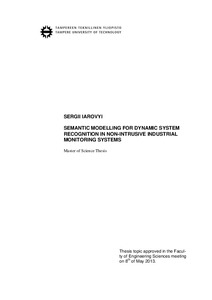Semantic modelling for dynamic system recognition in non-intrusive industrial monitoring systems
Iarovyi, Sergii (2014)
Iarovyi, Sergii
2014
Master's Degree Programme in Machine Automation
Teknisten tieteiden tiedekunta - Faculty of Engineering Sciences
This publication is copyrighted. You may download, display and print it for Your own personal use. Commercial use is prohibited.
Hyväksymispäivämäärä
2014-04-09
Julkaisun pysyvä osoite on
https://urn.fi/URN:NBN:fi:tty-201405131167
https://urn.fi/URN:NBN:fi:tty-201405131167
Tiivistelmä
Industrial monitoring systems play important role in decision making on all levels of a factory from the shop floor to ERP systems influencing overall efficiency of production. Together with a trend for mass customization and constantly increasing tempo of introduction of new products, equipment and technologies to manufacturing, contemporary monitoring systems should provide enough flexibility to be up to date with manufacturing system. Such monitoring systems as the one offered in European Commission project PLANTCockpit, offer the approach of extensively reconfigurable, loosely coupled systems. Unfortunately, configuration of the monitoring system which could work on all levels of automation hierarchy requires the knowledge of all those levels together with knowledge of integration technologies and tedious work related with creation of configuration itself.
Present thesis work offers an approach which automates the configuration process employing knowledge bases. This approach includes employment of SOA on device level, with semantically enhanced services descriptions (and possibility to employ the gateway devices for non-intrusiveness), definition of the metrics to be monitored by the system in the knowledge base, as well as set of algorithms and standards required to create configuration of the monitoring system. Reusability of knowledge defined on devices and in knowledge base simplifies the process of introduction of new devices, metrics or other reconfiguration of the monitoring system. The system implementing proposed approach has been developed in this thesis and was able to configure monitoring system for a test bed.
Present thesis work offers an approach which automates the configuration process employing knowledge bases. This approach includes employment of SOA on device level, with semantically enhanced services descriptions (and possibility to employ the gateway devices for non-intrusiveness), definition of the metrics to be monitored by the system in the knowledge base, as well as set of algorithms and standards required to create configuration of the monitoring system. Reusability of knowledge defined on devices and in knowledge base simplifies the process of introduction of new devices, metrics or other reconfiguration of the monitoring system. The system implementing proposed approach has been developed in this thesis and was able to configure monitoring system for a test bed.
